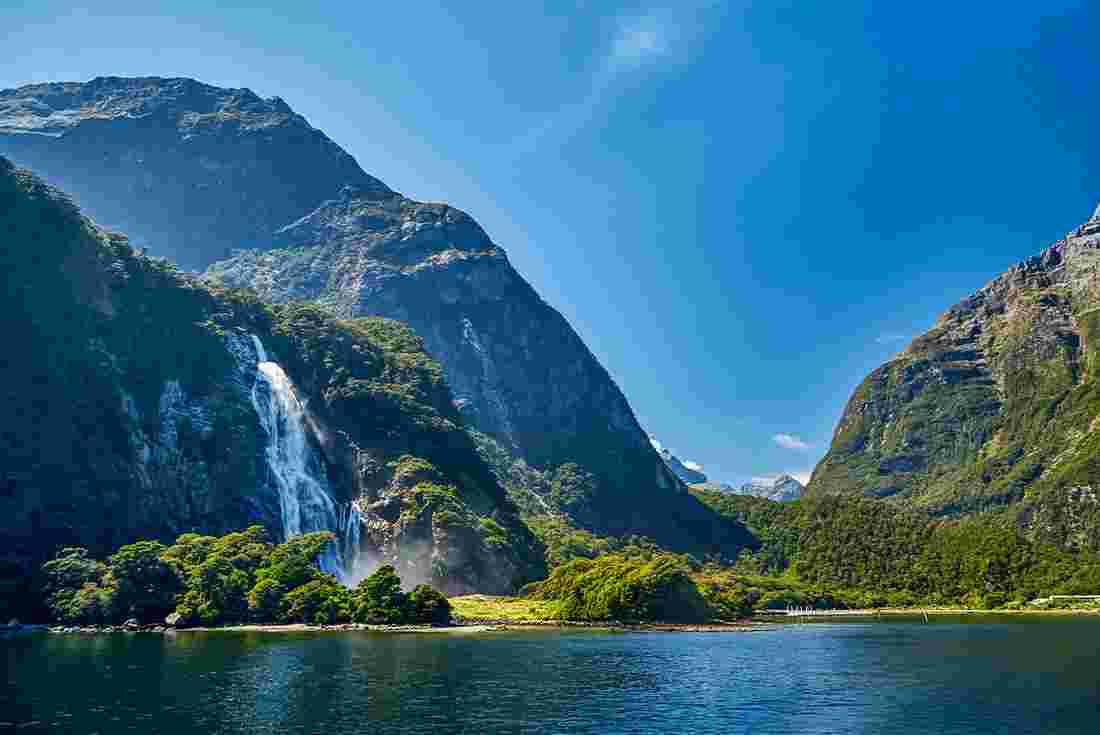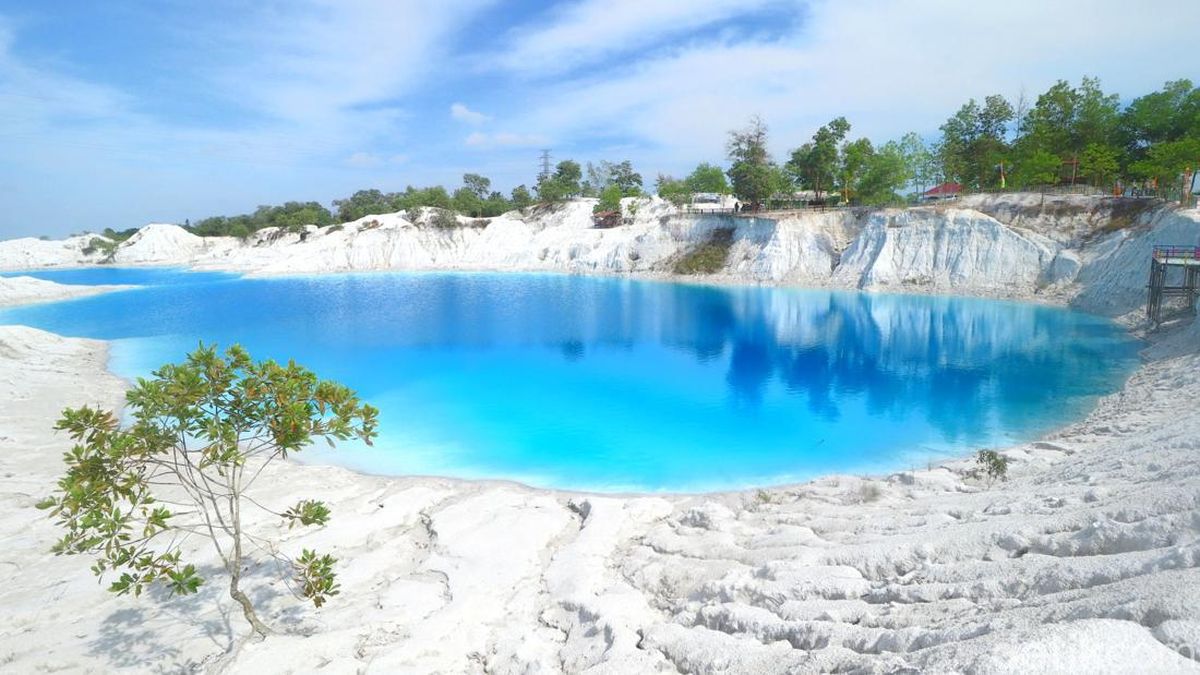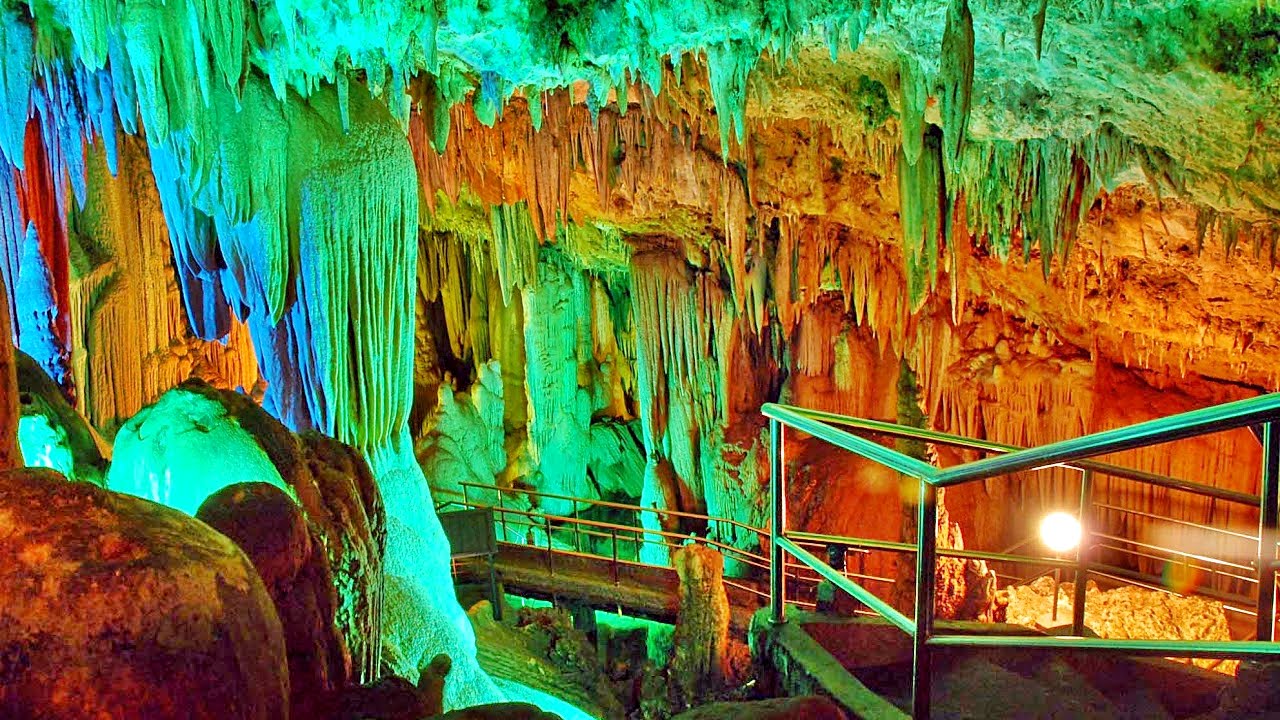
Fiordland National Park: Nestled in Fiordland’s remote southwestern corner lies nature’s crowning jewel, a lush wonderland shrouded in mystery yet waiting in eager anticipation to enthral and astound those fortunate enough to traverse its spellbinding terrain. As one of New Zealand’s largest national parks, spanning over 1.2 million acres, Fiordland harbors a collection of landscapes, from towering mountain peaks that kiss the sky to tranquil fjords caressed by forest and fed by waterfalls, that remain largely unspoiled by human footsteps.
Within these pages we uncover Fiordland’s bewitching essence, traversing its unique geography marked by valleys delved by glaciers and coastlines etched by centuries of weathering waves. Along the way we encounter an array of flora and fauna, from stately kauri and rimu trees that recall ancient Sentinels to birds like the South Island robin that delight with song.
Alongside scenic highlights and fascinating facts, this guide also outlines an assortment of outdoor activities for the intrepid spirit, from multi-day hiking adventures amidst fjordland’s rugged mountains to explorations of the crystal clear waters that are home to playful dolphins and seals.
Come then, and let us discover the hidden gems whispered about in hushed tones yet waiting in eager anticipation within this emerald wilderness that has enchanted all who pass through its spellbinding realm. Nestled in New Zealand’s remote South Island, jpslot Fiordland truly deserves pride of place on any nature lover’s list of must-visit destinations.

Contents
- 1 Location and Geography of Fiordland National Park
- 2 Flora and Fauna of Fiordland National Park
- 3 Activities and Attractions in Fiordland National Park
- 4 Milford Sound – the Crown Jewel of Fiordland National Park
- 5 Doubtful Sound – A Hidden Gem in Fiordland National Park
- 6 Accommodation Options in Fiordland National Park
- 7 How to Get to Fiordland National Park
- 8 Tips for Visiting Fiordland National Park
- 9 Conclusion
- 10 Author
Location and Geography of Fiordland National Park
Fiordland National Park is located in the southwestern corner of New Zealand’s South Island, adjacent to the Tasman Sea and the Southern Ocean. It spreads over an impressive 12,500 square kilometers, making it the largest national park in New Zealand and one of the largest parks in the world. The park’s landscape is nothing short of extraordinary, consisting of towering snow-capped mountains, deep glacial valleys, and a labyrinth of peaceful fiords eroded by the powerful forces of nature over thousands of years.
At the heart of Fiordland National Park is Milford Sound, one of New Zealand’s most iconic natural treasures and a UNESCO World Heritage Site. Doubtful Sound and Dusky Sound are other prominent fiords located within the park, while Preservation Inlet grants its visitors a unique, almost surreal experience. The park’s rugged terrain testifies to the transforming power of glaciation: numerous glaciers continue to grind through the park, with Tasman Glacier and Hooker Glacier performing the most notable work.
The massive presence of these frozen bodies has resulted in a range of distinctive geological formations characteristic for Fiordland National Park, such as steep-sided valleys, hanging valleys, and other U-shaped valleys.
Flora and Fauna of Fiordland National Park
Thirdly, nestled within Fiordland National Park lies a veritable Eden for the numerous endemic flora and fauna found nowhere else on Earth. The park’s lush rainforests shelter a singular variety of vegetation, including our country’s iconic silver beech towering majestically amongst stands of the rimu and delicate ferns whose primordial greenery imbues this place with an aura of timelessness.
Moreover, Fiordland is home to one of nature’s most intriguing avians – the New Zealand kea, the world’s largest and most ingenious parrot known for an insatiable curiosity and playfulness. Often seen soaring above the rugged mountains or scouring the alpine vales for their next meal, these birds epitomize the wild spirit of this remote domain. Additionally, Fiordland’s sounds and inlets comprise a habitat for several marine species where seals, dolphins and the endemic crested penguin may be glimpsed upon the shore.
Likewise, whale watching frequently rewards visitors with sightings of migrating humpback, southern right and killer whales. Within these forests and waters also thrive numerous other local denizens such as kiwi, weka and the enigmatic mohua, a diminutive songbird found nowhere beyond this park’s boundaries.
Activities and Attractions in Fiordland National Park
Fiordland National Park New Zealand, the country of dreams, encompasses unlimited treasures that can be discovered and observed by manpower. Fiordland is a suitable destination for each person. This is good news for those who like to visit the extensive area of forest, the pure beauty of landscape and water, or to hike through the vast open space away from roads and cars. A classic destination in Fiordland is the Milford Track, a multi-day treck this is said to be of the most magnificent trecks in the world.
It is the trip of 53.5 kilometers on which you can hike through the deserted forests and pass through the cold and snowy waterfall until you reach the peak of the Mckinon pass. Fiordland National Park also has other shorter trek such as the kepler trek and the Routhburn trek or you can arrive at the fiord by boat or kayak.
A boat or kayak will be your private water taxi that will take you to the fiordland coast, where you can appreciate the fine rock, cold falls and the marine beings that dwell in the fiords. Fishing and hunting trips in the New Zeland Fiordland which throw you up in the mountains and lands can also be another great experience.

Milford Sound – the Crown Jewel of Fiordland National Park
Undoubtedly, the centerpiece of the Fiordland National Park is Milford Sound. It is one of the most recognized natural attractions in the country. It was formed by ancient glacier and is a splendid demonstration of nature’s work over millennia. The fiord is encircled by sheer granite cliffs that climb more than 1,600 meters from the water surface, with dozens of waterfalls descending from its edges and slopes. There are many ways to explore Milford Sound. A cruise, a sea kayak, or even a flight-seeing journey will get a visitor the best possible look at the fiord.
Moreover, untouched waters of the sound are a home for Alaskas multiple marine species: this is home for seals, dolphins; the area is also home to Fiordland’s emblem species, the Fiordland crested penguin. Stirling Falls is also a feature very difficult to overlook. This waterfall is over 150 meters tall, and it drops straight into the fjord. A boat cruise can set a visitor right in its base to catch the mist. The views and ambiance of Milford Sound are amazing; indeed, this place is almost worthy of being named the Eight Wonder of the World.
However perhaps unjustly overshadowed by the glory of Milford Sound, nobody in their right mind would say that Fiordland National Park’s second most famous fjord – Doubtful Sound – that happens to be far more unique and picturesque anyway. If Milford Sound is the Sound Near the Ocean, Doubtful Sound is up to three times longer and is truly known as the Sound of Silence – a mecca for people in search of tranquility, peace and isolation. Doubtful Sound, Fiordland’s second-longest fjord, is more than 40 kilometers long and represents one of the untouched natural beauties on the planet.
Its mountains that seem to touch the sky, majestic rainforests that you cannot penetrate, and multiple waterfalls that fall right from the peak – this is a true splendor. Yes, exploring the fjord is a pleasure but coming here is especially interesting because of the underwater world that lives here. Seals, dolphins and the famous Fiordland crested penguin are seen here throughout the year. In summer humpbacks and orcas are occasionally seen in the sound.
You don’t have to take a cruise if you want to visit Doubtful Sound; you can go in a kayak or spend the night in one of the several secluded hotels in the national park. One of the most interesting events of the journey is the way to the most famous destination: the boat across Lake Manapouri and the bus to Wilmot Pass.
Accommodation Options in Fiordland National Park
Fiordland National Park offers a range of accommodation options to suit the needs and preferences of every traveler. From cozy lodges and eco-friendly cabins to remote wilderness campsites, there is something for everyone in this stunning natural paradise.
For those seeking a more luxurious experience, the park boasts several high-end lodges and resorts, such as the Fiordland Lodge and the Pio Pio Lodge, which offer stunning views, gourmet dining, and a range of amenities to make your stay truly memorable.
For the more adventurous, Fiordland National Park also offers a network of Department of Conservation (DOC) campsites and huts, which provide basic but well-maintained facilities for those wishing to immerse themselves in the park’s rugged wilderness. These campsites are accessible via the park’s extensive network of hiking trails, allowing visitors to truly disconnect from the outside world and connect with the natural beauty that surrounds them.
For those looking for a more unique accommodation experience, Fiordland National Park also offers several eco-friendly cabins and glamping sites, which provide a comfortable and sustainable way to experience the park’s untouched landscapes.
No matter your preferred style of accommodation, Fiordland National Park offers a range of options to suit every traveler, ensuring that you can fully immerse yourself in the park’s breathtaking natural wonders.

How to Get to Fiordland National Park
Fiordland National Park is located in the remote southwestern corner of New Zealand’s South Island, making it a bit of a challenge to reach for some travelers. However, the journey to this natural wonder is just as rewarding as the destination itself.
The most common way to reach Fiordland National Park is by driving from the nearby town of Te Anau, which serves as the main gateway to the park. The scenic drive from Te Anau to Milford Sound, the most popular destination within the park, takes approximately 1.5 hours and offers breathtaking views of the surrounding landscapes.
Alternatively, visitors can also access Fiordland National Park by taking a scenic flight from Queenstown or Invercargill, which provides a unique bird’s-eye view of the park’s rugged terrain and stunning fiords. These flights often include a landing at Milford Sound, allowing visitors to explore the area further on foot or by boat.
For those seeking a more adventurous journey, the Milford Track can be accessed from the town of Te Anau, with hikers embarking on a multi-day trek through the heart of the park. This renowned hike is considered one of the best in the world and offers a truly immersive experience in Fiordland’s untouched wilderness.
No matter how you choose to reach Fiordland National Park, the journey is sure to be an unforgettable experience, with stunning scenery and a sense of adventure around every corner.
Tips for Visiting Fiordland National Park
As with any remarkable natural destination, there are a few tips and considerations to keep in mind when planning your visit to Fiordland National Park:
- Plan Ahead: Fiordland National Park is a popular destination, especially during the peak summer months. Be sure to book your accommodation, activities, and transportation well in advance to ensure availability.
- Pack Wisely: The weather in Fiordland can be unpredictable, with sudden changes in temperature and rainfall. Pack layers, rain gear, and sturdy hiking boots to ensure you’re prepared for any conditions.
- Be Prepared for Adventure: Many of the park’s activities, such as hiking and kayaking, require a moderate to high level of physical fitness. Make sure you’re in good shape and have the necessary skills before embarking on any challenging excursions.
- Respect the Environment: Fiordland National Park is a pristine and fragile ecosystem. Be mindful of your impact and follow all park regulations and guidelines to help preserve the natural beauty of the area.
- Consider a Guided Tour: While it’s possible to explore Fiordland on your own, joining a guided tour can provide valuable insights and ensure you don’t miss any of the park’s hidden gems.
- Allow Plenty of Time: Fiordland National Park is vast and there’s so much to see and do. Plan to spend at least a few days in the park to fully immerse yourself in its natural wonders.
By keeping these tips in mind, you’ll be well on your way to an unforgettable and enriching experience in the untouched beauty of Fiordland National Park.
Conclusion
Fiordland National Park is a true natural wonder that has the power to captivate and inspire all who visit. From the towering peaks and pristine fiords to the diverse array of flora and fauna, this untouched wilderness offers a truly unique and immersive experience that is sure to leave a lasting impression.
Whether you’re an avid hiker, a nature enthusiast, or simply someone who appreciates the grandeur of the great outdoors, Fiordland National Park has something for everyone. From the iconic Milford Sound to the serene Doubtful Sound, and the countless hiking trails and outdoor adventures in between, this remarkable destination is a must-visit for any traveler to New Zealand. If you enjoyed reading this article, please consider reading our article about Ancient Egypt for more fascinating explorations of history and nature.







